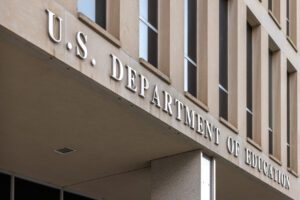Many students borrow to afford the costs of their college educations. But sometimes, life gets in the way, and it’s not possible to finish earning a degree. If that happens to you, you will need to learn what happens to student loans when you drop out.
What happens to student loans if you withdraw?
If you are considering leaving school, you should be aware that doing so could require you to begin making student loan payments. However, the specific rules for what happens to student loans when you drop out can vary depending on whether you have federal or private student loans.
Federal student loans after withdrawing
If you have taken out federal student loans, your loan will go into repayment once you:
- Graduate
- Drop below ½ time enrollment
- Leave school for any reason
You will have a grace period, though, so you don’t have to worry about immediately paying back student loans after dropping out. The length of the grace period depends on the type of loan you have.
- If you have a Direct Subsidized or Unsubsidized Loan or a Federal Family Education Loan (FFEL), then you will have a six-month grace period.
- If you have a Perkins Loan, you will have a nine-month grace period.
At the end of the grace period, you need to begin paying back the borrowed amount.
Private student loans after withdrawing
If you have private student loans, it can be a bit more complicated to understand what happens to student loans when you drop out. That’s because the specific requirements can vary by lender. In general, however, most private student loan lenders also require you to begin making payments after enrollment drops below half time. Private lenders may offer a grace period as well, which is usually six months but could be shorter or longer depending on lender and loan type.
Is there student loan forgiveness for dropouts?
Student loan forgiveness is not available just because you decide not to complete your academic program. You are still responsible for repaying the full balance of loans. That’s why it is so important to understand what happens to student loans if you withdraw. In rare cases, it may be possible to have some of your federal loans discharged if you cannot complete your degree. For example, you could have Direct Loans, FFEL Program loans, and Perkins Loans discharged if your school closes while you are still enrolled or soon after you withdraw. If your school falsely certified your eligibility to receive a loan or if you withdrew and the school failed to make a required return of borrowed funds, then you could also be eligible for discharge for some or all of your federal student loan debt. However, outside of these limited circumstances, you typically will not qualify for any special loan forgiveness just because you left school. You can, however, qualify for some of the same types of student loan forgiveness any borrower is eligible for. This includes loan forgiveness based on public service work or based on your participation in an income-driven payment plan.
Tips for paying back student loans after dropping out
Once you know what happens to student loans if you withdraw, you will need to make a plan for paying back student loans after dropping out. This could be a challenge if you didn’t earn a degree since you may not have the boosted earning power that usually comes with finishing your academic program. Some of your options include:
- Deferment: If you have federal student loans, you may be able to qualify for student loan deferment if you meet certain criteria, such as demonstrated economic hardship. Deferment can pause payments temporarily. During the time when they are paused, no interest will accrue on Direct Subsidized Loans.
- Forbearance: Forbearance may be available for both federal and private student loans for a limited period of time. This also allows you to pause payments temporarily. Unfortunately, interest will keep accruing while loans are in forbearance, so taking advantage of this option could ultimately make your loans more expensive to pay back.
- Repayment plans: Private student loan lenders may be willing to work with you to temporarily reduce payments during times of economic hardship
Deferment, forbearance and repayment plans are temporary solutions. Ultimately, you will need to develop a long-term plan for paying back student loans after dropping out. This could include:
- An income-driven repayment (IDR) plan: Federal student loans provide the option to enter into a payment plan that caps payments as a percentage of monthly income. If you make payments for a certain number of years, but you still have an outstanding loan balance, the remaining amount due is forgiven.
- Refinancing student loans: You may be able to refinance student loans and get a lower interest rate and more favorable repayment terms. Keep in mind that refinancing federal student loans will require you to give up federal borrower benefits such as income-driven repayment and loan Public Service Loan Forgiveness (PSLF) options.
Ultimately, dropping out of school can make paying student loans harder. If you can find a way to avoid leaving early so you can finish your degree, you may end up better off in the long run. But if leaving school becomes necessary due to your life circumstances or a change in your goals, the important thing is to be proactive about finding a solution to paying back student loans after dropping out, so you don’t damage your finances over the long term.



